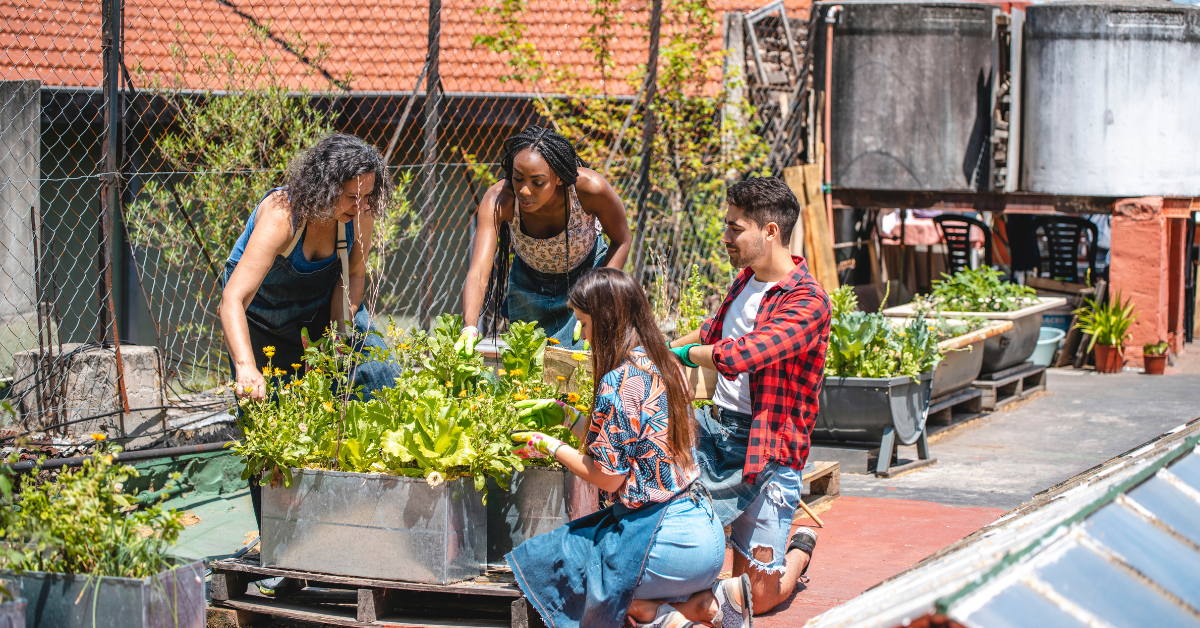My name is Daisy Mendoza and I’m a 2022 high school graduate of Johnson Senior High School. I had enlisted in the Army National Guard and although my journey to my contract was cut short, I decided to take a new journey in enhancing my writing skills and a goal to explore, learn, and grow with my community. I live on the East side of Saint Paul, Minnesota, only a few blocks away from one of many lakes, Lake Phalen. I enjoy taking time to give back to the community as those within it have helped me to grow as not only a person, but a citizen dedicated to serving their community. Rice Street Gardens is a place of pride in our community.
On Rice Street in Roseville, Minnesota, across from Galilee Church is a community garden which covers about 2 acres of land, part of 12 acres that is home to over a thousand trees. The Rice Street Gardens contains over 260 16 X 20 plots of land for those in the community to grow their own plants.
Who is here: people
Many of those who take part in gardening in this specific area are immigrants from around the world with more than 10 languages spoken at Rice Street Gardens. With over 70,000 residents living within a three mile radius of the gardens, this community ground has become so popular that there is almost always a wait list for every new season. Many of these residents live in apartments and don’t have the opportunity to grow their own fresh food. Many of those residents within walking distance are food insecure and dependable on Rice Street Gardens for essential nourishment, especially during Minnesota’s cold winters where gardening will have to cease for the season. Many have volunteered to help maintain the community garden. Mowing the lawns, keeping water tanks full, turning over compost piles, and multiple other tasks are done by a team of gardeners who ensure a pesticide and chemical free gardening environment. Mid-October is when all plots are cut down to under ten inches and all fences removed in preparation for the next growing season. Entering the new year, 2023 will be the beginning of the garden’s seventh year.
Who is here: animals
People are not the only ones who want to eat from these gardens. To date, there are four different types of pests in the gardens: Japanese beetles, mice, rabbits, and deer. Actions to prevent these creatures from contaminating the garden had been placed, from trapping the Japanese beetles, to providing an owl house for the rodents, and building a fence to keep the deers out, had yet to completely work but did provide some insight on how well creatures also loved the garden. Although the garden is just across the street from the Galilee Lutheran Church, it is actually a part of Maplewood which you enter once crossing the street.
At the beginning of growing this garden, water was not so easily accessible. Luckily for the crew in charge of the gardens, the restaurant/bar right next to their gardens offered them access to water by providing a well. With the installation of irrigation from the well, hosts of the garden were then able to provide 6 water tanks, all of which have hoses and a spigot. With this action and aid of the well, all 260 plus plots of land are reachable by hose.
Who is here: community partners
Across the street from Rice Street Gardens is a Lutheran Church. This place, where many locals can gather to attend many events including church services, is a proud supporter of the local Rice Street Gardens, helping to build community and access to healthy, chemical-free produce. The Galilee Church supports the Rice streets gardens, helping to provide a place to grow fresh vegetables and fruits for any meal. There have long been positive articles about the Rice Street Gardens in both the Pioneer Press and the Star Tribune St. Paul newspapers.
These gardens provide a fun, friendly environment where the community can get together and enjoy their common hobby of gardening. With Pastor Dana Nelson at this church, many youth groups have requested to volunteer and help in the gardens. Learning about and contributing to Rice Street Gardens has expanded as far North Dakota and Iowa, with residents willing to learn about the gardens and help in any way possible.
God is here
Being able to provide food from hard work connects us all back to God. God gave us the soil we use for the base of our healthy plants, rains that water and the sun that shines to provide the plants all they need for healthy growth. Gardeners provide the final step of loving and caring for the plants, bringing them home to provide food for family and friends, giving their effort and time to provide for their family a meal. We can thank God for the resources and connections that make this all possible.
Questions for reflection or discussion:
- Who are your human and animal neighbors?
- How do they access healthy food?
- Who are other potential partners in turning land into space for growing food: churches or businesses?




